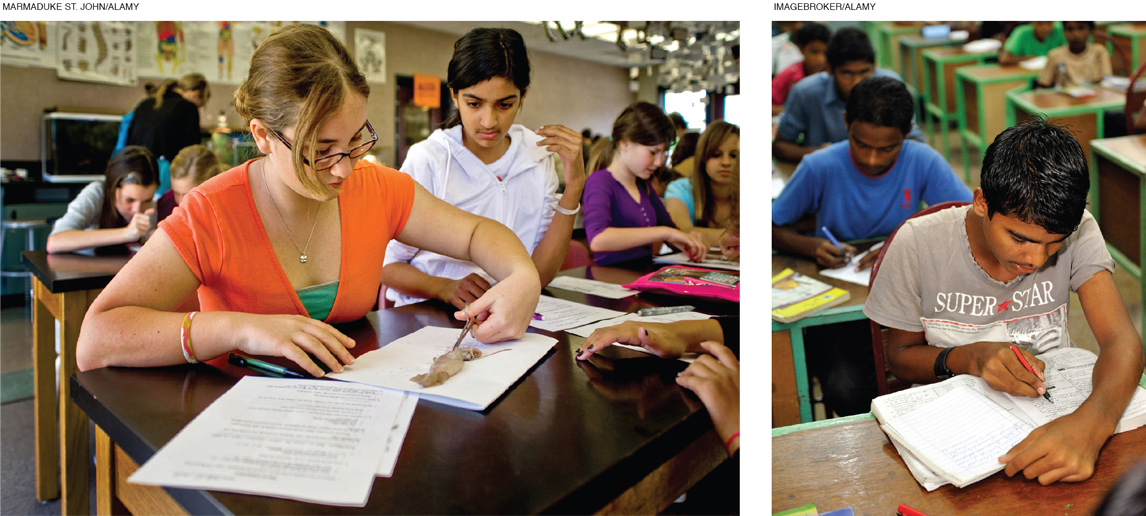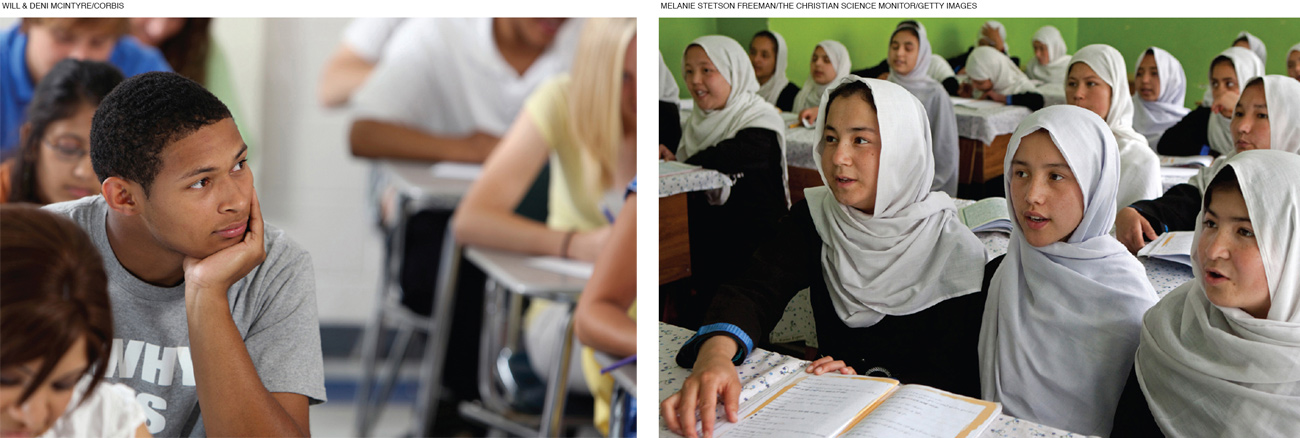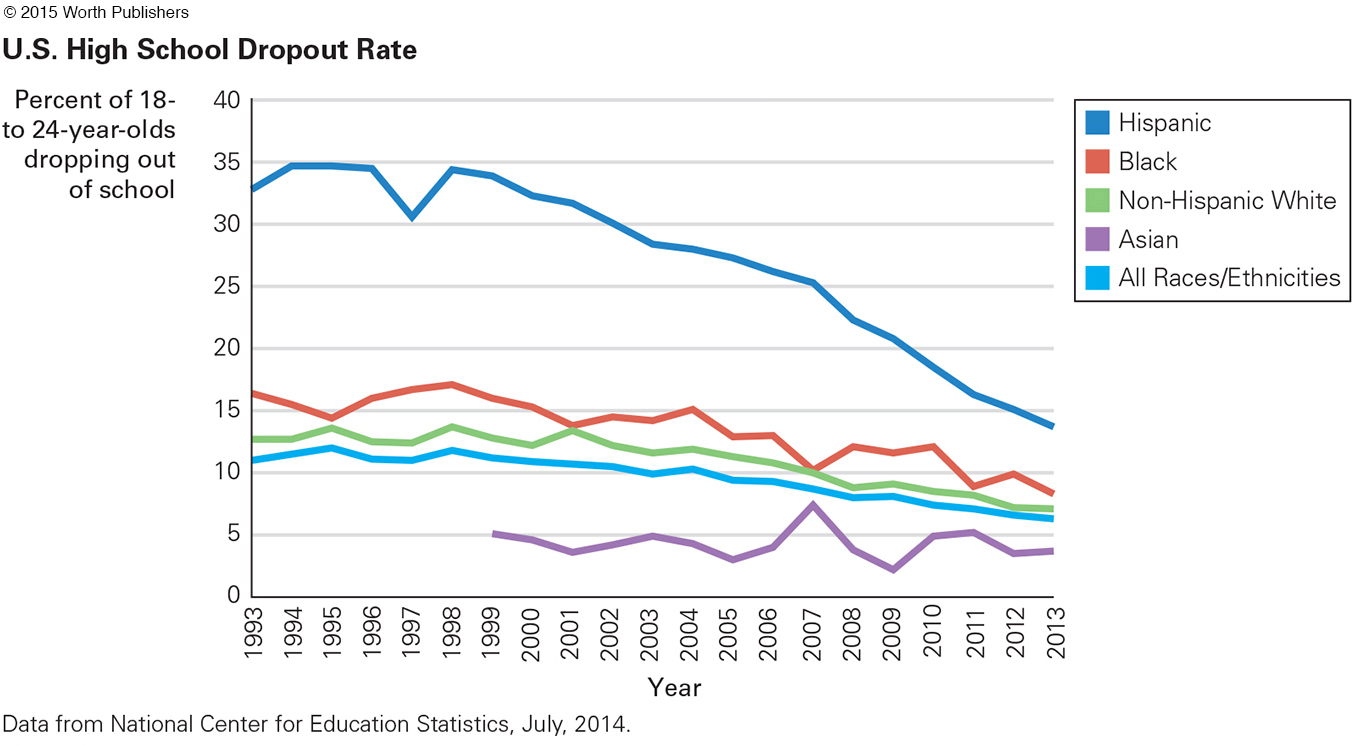Teaching and Learning
What does our knowledge of adolescents imply about school? As you have read, adolescents are capable of deep and wide-
Education is crucial for later life, but the quality of schooling matters. A year of school can propel thinking forward or can have little impact: What matters is how much learning occurs, not how much time has elapsed (Hanushek & Woessmann, 2015).
Consequently, educators, developmentalists, political leaders, and parents wonder exactly which curricula and school structures are best for 11-
No single school structure or style of pedagogy seems best for everyone. Various scientists, nations, schools, and teachers try many strategies, some based on opposite but logical hypotheses.
secondary education
Education that follows primary education (elementary or grade school) and precedes tertiary education (college). It usually occurs from about age 11 to age 18, although there is some variation by school and by nation.
Secondary education—traditionally grades 7 through 12—
Adults are healthier and wealthier if they complete secondary school. This is true within nations and between them, for people of every ethnicity, gender, and SES. Even something seemingly unrelated to education—
Middle School
middle school
A school for children after elementary school and before high school, usually grades 6 through 8.
In many nations, two levels of secondary education are provided, once called senior high and junior high. As the average age of puberty declined, middle schools were created for grades 6 to 8, and sometimes for grades 5 to 8.
Moving from primary to middle school is stressful, because teachers, classmates, and expectations all change during a developmental period considered especially crucial for learning (McGill et al., 2012). Many developmentalists find middle schools to be “developmentally regressive” (Eccles & Roeser, 2010, p. 13), which means learning goes backward at the very time it could speed up.

Question 9.34
OBSERVATION QUIZ
Although there are many differences in these classrooms, they share one part of the hidden curriculum. What is it?
Both are single-
For example, a longitudinal study of primarily European American students found a decline in school interests and grades from age 7 to 16, with a notable dip in the transition to middle school (Dotterer et al., 2009). A similar middle school decline in school engagement occurred in research on African American and Latino students (McGill et al., 2012; Hayes et al., 2015).
Indeed, students of every group tend to dislike middle school, for good reason. Bullying increases in middle school, particularly in the first year (Baly et al., 2014), and friendship with either sex is complicated by unfamiliar sexual urges. Students are less likely to have supportive adults, partly because young adolescents seek independence and partly because the school undercuts student–
Parents underestimate the stress of day-
Unlike primary school, where each classroom has one teacher all year, middle school teachers may have hundreds of students. Teachers become impersonal and distant, opposite to the direct, personal engagement that young adolescents need. Thankfully, some middle schools are organized to allow teachers to have fewer students (such as the same teacher instructing in English and history), but many more keep the old model.
Early signs of a future high-
To pinpoint the developmental mismatch between students’ needs and the middle school context, note that just when egocentrism leads young people to feelings of shame or fantasies of stardom (the imaginary audience), schools typically require them to change rooms, teachers, and classmates every 40 minutes or so. That makes both public acclaim and supportive new friendships difficult to achieve.
Recognition for academic excellence or for conscientious work is especially elusive because middle school teachers assign marks more harshly than their primary school counterparts. Effort without accomplishment is not recognized, and achievement that earlier was “outstanding” is now only average.
Acclaim from after-
THINK CRITICALLY: Would there be less bullying if more schools were multiethnic?
Many middle school students seek acceptance from their peers. Bullying increases, physical appearance becomes more important, status symbols are displayed (from gang colors to trendy sunglasses), expensive clothes are coveted, and sexual conquests are flaunted. Of course, much depends on the cultural context, but almost every middle school student seeks peer approval in ways that adults disapprove (Véronneau & Dishion, 2010).
COPING WITH MIDDLE SCHOOL One way to cope with stress is directly cognitive. Students may blame classmates, teachers, parents, or governments for problems, and that removes some anxiety, as well as some responsibility, from them.
This may explain the surprising results of a Los Angeles study: Students in schools that were more ethnically mixed felt safer and less lonely. It was not that they had more friends from other groups. Instead, if they felt alone or performed poorly, they could “attribute their plight to the prejudice of other people” rather than blame themselves (Juvonen et al., 2006, p. 398). Furthermore, members of each minority group tended to support and defend each other, giving everyone some ethnic allies.
Another way middle school students avoid failure is to quit trying. Then they can blame a low grade on their choice (“I didn’t study”) rather than on their ability. Pivotal is how they think of their potential, according to a series of studies inspired by Carol Dweck’s understanding that the interpretation of intellectual achievement is crucial, as already mentioned in Chapter 8.
entity theory of intelligence
The idea that intellectual ability is innate, a fixed quantity present at birth. Those who hold this view underrate the role of effort on achievement.
If students have an entity theory of intelligence (i.e., that ability is innate, a fixed quantity present at birth), then they will conclude that nothing can be done to improve their academic skill. Thus, if they think they are innately incompetent at math, or reading, or whatever, they mask the self-
incremental theory of intelligence
The idea that intelligence can be increased by effort, with attention and practice, as in class participation and homework.
By contrast, if adolescents adopt the incremental theory of intelligence (i.e., that intelligence can increase if they work to master whatever they seek to understand), then they will pay attention, participate in class, study, complete their homework, and learn.
This is not hypothetical. In the first year of middle school, students with entity beliefs do not achieve much, whereas those with mastery motivation improve academically. This has been found in many nations, including Norway (Diseth et al., 2014), China (Zhao & Wang, 2014), and the United States (Burnette et al., 2013; Romero et al., 2014).
The contrast between the entity and incremental theories is also apparent for teachers, parents, schools, and cultures. If the hidden curriculum endorses competition among students and if class composition or curriculum conveys the message to some students that they are not “college material,” that is entity theory. Then students are less likely to study or help each other (Eccles & Roeser, 2011).

International comparisons reveal that educational systems that track students into higher or lower classes, that expel low-
Older Adolescents in School
Many of the patterns and problems of middle school continue in high school, although with puberty over, adolescents are better able to cope. As we have seen, adolescents become increasingly able to think abstractly, analytically, hypothetically, and logically (all formal operational thought) as well as subjectively, emotionally, intuitively, and experientially. High school curricula and teaching methods often require the former mode.
THE COLLEGE-
In several nations, adults hope to raise standards so that all high school graduates will be ready for college. For that reason, U.S. schools are increasing the number of students who take classes that are assessed by externally scored exams, either the IB (International Baccalaureate) or the AP (Advanced Placement). Such classes satisfy some college requirements if the student scores well. More and more students take such classes: 33 percent of high school graduates did so in 2013, compared to 19 percent in 2003 (Adams, 2014).
high-
An evaluation that determines something very important. For example, if a single test determines promotion or graduation, it is a high-
In addition to mandated courses, 24 U.S. states now also require students to pass a high-
The worry, of course, is that raising standards and requiring a high-

COLLEGE FOR EVERYONE? In the United States, some (about 30 percent) high school graduates do not enter college. Moreover, of those who enter public community colleges, most (about three-
Internationally, students who do not attend college but instead take courses that explicitly prepare them for employment (combining academic classes and practical experience) get better-
One problem in the United States is that many parents and teachers believe that every student should graduate and then go on to college. Some adolescents resist adult pressure by failing. At the other extreme, many students with high grades and test scores do not enroll for reasons other than ability.
Encouragement and opportunity varies from place to place. That may explain why students who entered ninth grade with high achievement scores in two major cities in neighboring states (Albuquerque, New Mexico and Fort Worth, Texas) had markedly different rates of college enrollment (83 percent compared to 58 percent) (Center for Education Policy, 2012).
THINK CRITICALLY: Is it more important to prepare high school students for jobs or for colleges?
The data present a dilemma. Suggesting that a student should not go to college may be racist, classist, sexist, or worse. On the other hand, many students who begin college do not graduate, so they lose time and gain debt when they could have advanced in a vocation. Everyone agrees that adolescents need to be educated for life as well as employment, but it is difficult to decide what that means.
MEASURING PRACTICAL COGNITION Employers usually provide on-
As one executive of Boeing (which hired 33,000 new employees in two years) wrote:
We believe that professional success today and in the future is more likely for those who have practical experience, work well with others, build strong relationships, and are able to think and do, not just look things up on the Internet.
[Stephens & Richey, 2013, p. 314]
Those skills are hard to measure, especially on national high-
PISA (Programme for International Student Assessment)
An international test taken by 15-
A third set of international tests, the PISA (Programme for International Student Assessment), was designed to measure students’ ability to apply what they have learned. The PISA is taken by 15-
For example, among the 2012 math questions on the PISA is this one:
Chris has just received her car driving license and wants to buy her first car. The table below shows the details of four cars she finds at a local car dealer.
| Model | Alpha | Bolte | Castel | Dezal |
|---|---|---|---|---|
| Year | 2003 | 2000 | 2001 | 1999 |
| Advertised price (zeds) | 4800 | 4450 | 4250 | 3990 |
| Distance travelled (kilometers) | 105 000 | 115 000 | 128 000 | 109 000 |
| Engine capacity (liters) | 1.79 | 1.796 | 1.82 | 1.783 |
What car’s engine capacity is the smallest?
A. Alpha B. Bolte C. Castel D. Dezal
For that and the other questions on the PISA, the math is simple—
One problem is decimals: Some students do not remember how to interpret them when a practical question, not an academic one, is asked. Another problem on this question is that distance traveled and price are irrelevant, yet many students are distracted by them.
Overall, the U.S. students perform lower on the PISA compared to many other nations. In the 2012 assessments, U.S. scores are markedly below 27 other educational systems, below the PISA average in science and math, and they are just about average in reading. International analysis finds that the following items correlate with high achievement (OECD, 2010, p. 4):
Leaders, parents, and citizens value education overall, with individualized approaches to learning so that all students learn what they need.
Standards are high and clear, so every student knows what he or she must do, with a “focus on the acquisition of complex, higher-
order thinking skills.” Teachers and administrators are valued, and they are given “considerable discretion” in determining content and sufficient salary as well as time for collaboration.
Learning is prioritized “across the entire educational system,” with high-
quality teachers working in the most challenging environments.
The PISA and international comparisons of high-
A study of student emotional and academic engagement from the fifth to the eighth grade found that, as expected, the overall average was a slow and steady decline of engagement, but a distinctive group (about 18 percent) were highly engaged throughout while another distinctive group (about 5 percent) experienced precipitous disengagement year by year (Li & Lerner, 2011). The 18 percent are likely to do well in high school; the 5 percent are likely to drop out. Schools and teachers need many strategies if they hope to reach every adolescent.
Now let us consider a general conclusion for this chapter. The cognitive skills that boost national economic development and personal happiness are creativity, flexibility, relationship building, and analytic ability. Whether or not an adolescent is college-
Every cognitive theorist and researcher believes that adolescents’ logical, social, and creative potential is not always realized, but that it can be. Does that belief end this chapter on a hopeful note?
WHAT HAVE YOU LEARNED?
Question 9.35
1. What characteristics of middle schools make them more difficult for students than elementary schools?
Having different teachers for each subject can make middle school teachers seem impersonal and distant; unlike elementary school, no one teacher is aware of a student’s overall academic performance and social behavior. Changing classes for each period can make personal recognition from authority figures difficult at a time when such recognition is important. This can contribute to students developing a feeling of alienation from school and teachers. Students already at risk for emotional problems may react to the transition by experiencing intense anxiety or depression.
Question 9.36
2. How does the teacher–
In primary school, one teacher has the same students all day long. But in middle school, teachers may have hundreds of students in their classrooms each day, making them more impersonal and less accessible.
Question 9.37
3. How does puberty affect a person’s ability to learn?
Early adolescents are egocentric, a quality that is mismatched with the impersonal context of middle school. While middle-
Question 9.38
4. How do beliefs about intelligence affect motivation and learning?
If they hold to the entity theory of intelligence, students believe that nothing they do can improve their academic skill. Entity belief can reduce motivation and learning. If they hold to the incremental theory of intelligence, students believe that effort is important to achievement. Incremental belief is associated with higher motivation and learning.
Question 9.39
5. What evidence is there that standards for high school education are rising?
In the United States, schools are increasing the number of students who take International Baccalaureate (IB) or Advanced Placement (AP) classes, which are assessed by externally scored exams and satisfy some college requirements if students do well. Furthermore, almost half of all U.S. states now require students to pass an exit exam in order to graduate.
Question 9.40
6. What are the advantages and disadvantages of high-
The effect of such tests on education is in dispute. High school graduation rates in the United States are inching upward, with 72 percent of ninth-
Question 9.41
7. Why do U.S. high schools strive to prepare everyone for college?
Many teachers and parents in the United States believe that every student should go to college after graduating from high school, and suggesting that certain students should not go to college and instead take courses that prepare them for employment may be considered by some to be racist or classist.
Question 9.42
8. What do high school students who do not go to college need to learn?
They need practical experience—
Question 9.43
9. How does the PISA differ from other international tests?
The PISA measures the students’ ability to use skills they learned in school to cope with real-
Question 9.44
10. What characteristics are shared by nations with high PISA scores?
(1) There is an overall appreciation for education among leaders, parents, and citizens, with individualized approaches to learning; (2) National educational standards are high and clear to all students; and (3) Teachers and administrators are valued, have considerable say in determining educational content, and are compensated sufficiently.